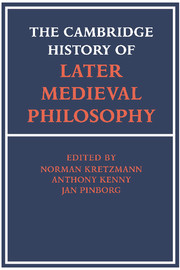 The Cambridge History of Later Medieval Philosophy
The Cambridge History of Later Medieval Philosophy Book contents
- Frontmatter
- Introduction
- I Medieval philosophical literature
- II Aristotle in the middle ages
- III The old logic
- IV Logic in the high middle ages: semantic theory
- 7 The origins of the theory of the properties of terms
- 8 The Oxford and Paris traditions in logic
- 9 The semantics of terms
- 10 The semantics of propositions
- 11 Syncategoremata, exponibilia, sophismata
- 12 Insolubilia
- 13 Speculative grammar
- V Logic in the high middle ages: propositions and modalities
- VI Metaphysics and epistemology
- VII Natural philosophy
- VIII Philosophy of mind and action
- IX Ethics
- X Politics
- XI The defeat, neglect, and revival of scholasticism
- Index nominum
- Index rerum
- References
10 - The semantics of propositions
from IV - Logic in the high middle ages: semantic theory
Published online by Cambridge University Press: 28 March 2008
- Frontmatter
- Introduction
- I Medieval philosophical literature
- II Aristotle in the middle ages
- III The old logic
- IV Logic in the high middle ages: semantic theory
- 7 The origins of the theory of the properties of terms
- 8 The Oxford and Paris traditions in logic
- 9 The semantics of terms
- 10 The semantics of propositions
- 11 Syncategoremata, exponibilia, sophismata
- 12 Insolubilia
- 13 Speculative grammar
- V Logic in the high middle ages: propositions and modalities
- VI Metaphysics and epistemology
- VII Natural philosophy
- VIII Philosophy of mind and action
- IX Ethics
- X Politics
- XI The defeat, neglect, and revival of scholasticism
- Index nominum
- Index rerum
- References
Summary
Terms and propositions
Separate treatments of the semantics of terms and the semantics of propositions are justified by the Aristotelian distinction between two levels of speech and thought (Categories 1a16, 2a4; De interpretatione 16a10): the level of names and verbs and the thoughts corresponding to them, which do not yet involve any combination (symplokē, complexio) that makes the notions of truth and falsity applicable, and the level of expressions and thoughts formed by a kind of combination that has to do with truth and falsity. Just as Aristotle had made the applicability of the notions of truth and falsity the criterion for the relevant kind of combination, the medieval semantics of complex units of speech and thought (complexa) concentrated on sentences that are used for making statements and are thus either true or false – the sort of sentences with which logic is primarily concerned. A combination of words that is used to make known something that is either true or false (oratio verum falsumve significans) was called an enuntiatio or propositio. The Latin word ‘propositio’ practically always designates a declarative sentence; accordingly, in this chapter ‘proposition’ is used in this medieval sense and never in the modern sense of that which is expressed by a declarative sentence. Most medievals were aware of a distinction between a complexio in the sense of mere predication, without any assertive (or other) force, and a complexio which is accompanied by an act of judging or asserting that it is so.
- Type
- Chapter
- Information
- The Cambridge History of Later Medieval PhilosophyFrom the Rediscovery of Aristotle to the Disintegration of Scholasticism, 1100–1600, pp. 197 - 210Publisher: Cambridge University PressPrint publication year: 1982
References
- 3
- Cited by
